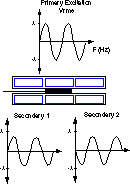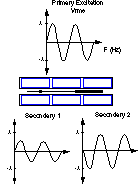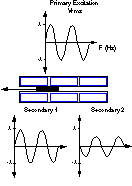Resources
LVDT Technology
Trans-Tek designs and manufactures a broad line of linear displacement transducers using LVDT technology. An LVDT, or Linear Variable Differential Transformer, is an inductive device containing primary and secondary coaxial wound coils, and a ferromagnetic core. Exciting the primary coil with an AC voltage generates an electromagnetic field. The core links the electromagnetic field of the primary coil to the secondary coils, inducing a voltage in each. The secondary coils are typically wired in series opposition, producing AC voltages 180 degrees out of phase with each other. The magnitude of the voltage in each secondary depends on the position of the core relative to the coils.
 When the physical center of the core is in line with the electrical center of the coils, the voltage in each secondary is equal in magnitude, but opposite in phase. Differencing the two secondary voltages results in “zero” output volts. This is the null position of the LVDT.
When the physical center of the core is in line with the electrical center of the coils, the voltage in each secondary is equal in magnitude, but opposite in phase. Differencing the two secondary voltages results in “zero” output volts. This is the null position of the LVDT.
In reality, there is a small residual voltage left due to factors like winding capacitance and variances in the magnetic materials. Internal or external signal conditioning electronics compensate for this residual voltage, producing a true electrical zero output.

 An LVDT is designed to have symmetric measurement ranges on each side of null. As the core moves to one side of the null position, the magnitude of one secondary becomes greater than the other. Differencing the two secondary voltages results in a voltage proportional to the core’s distance from null. The phase of this voltage tells us which side of null the core is on.
An LVDT is designed to have symmetric measurement ranges on each side of null. As the core moves to one side of the null position, the magnitude of one secondary becomes greater than the other. Differencing the two secondary voltages results in a voltage proportional to the core’s distance from null. The phase of this voltage tells us which side of null the core is on.
DC-DC LVDT Operation
Signal conditioning is an important consideration when designing an LVDT into an application. Converting the AC output voltage of the secondaries into a usable DC output voltage requires a demodulator and low pass filtering. Design of the circuitry must take into account frequency response and electrical noise considerations. For convenience and ease of use, Trans-Tek manufactures a complete line of DC-DC LVDTs, also known as DCDTs, containing an integral oscillator/demodulator.
Discrete components make up the integral signal conditioner. The oscillator converts the DC voltage input to a high frequency AC voltage, powering the primary coil. A passive demodulator rectifies and differences the AC voltage output from the secondaries before filtering the signal with a low pass RC filter. The magnitude and polarity of the DC output voltage are dependant on the position of the core relative to the null position.
Trans-Tek’s DC LVDTs are input polarity protected, meaning that polarity of the input leads must be observed for proper operation, but the unit will not be damaged by polarity reversal. The DC voltage input can range from 6 to 28 VDC, and must be regulated for best accuracy. The magnitude of the output voltage is controlled by the input voltage. These DC LVDTs also feature input and output circuits isolated both from each other and the coil housing. The result is a transducer which can be used in a floating or ground return system.

